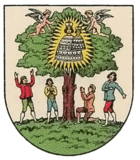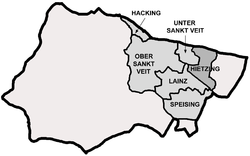Hietzing (district of Vienna)
| Hietzing | |
|---|---|
| coat of arms | map |

|

|
Hietzing [ ˈhɪtsɪŋ ] was a suburb of Vienna that gained special social importance in the 19th century due to its proximity to the imperial summer residence of Schönbrunn Palace and entertainment venues. Hietzing has been the eponymous part and (located in the part of the district facing the city center) since 1892 the center of Vienna's 13th district Hietzing . In addition, the former community of Hietzing is one of the Viennese cadastral communities in the land registry . To distinguish it from the whole district, the former place is called Alt-Hietzing .
Location, general
The village of Hietzing (like the 13th district since 1938) had its northern border on the Wien River , on the north, left bank of which the neighboring village of Penzing (also incorporated in 1892, eponymous part of the 14th district since 1938) lies. In the east the village was (and is) bounded by the wall of the Schönbrunn Palace Park, which is why traffic to Vienna (to today's city center) was (or is) only possible along the Vienna River. In the southwest, Lainz , today part of the 13th district, was the next neighboring village. In the west, the Lower St. Veit , built in the 19th century, borders on Alt-Hietzing. Alt-Hietzing has grown together with the former neighboring towns to such an extent that its former borders are no longer visible today (with the exception of the Vienna River and the castle park wall).
From the traditional Alt-Hietzings shopping center , Lainzer Straße leads south-west into the geographically but not functionally centrally located district of Lainz . The Hietzinger main street connects to lower and upper St. Veit in the west. The older Auhofstrasse runs parallel to the Wien River, also to the west, at a safe distance from the flood, to the Auhof on the northern edge of the Lainzer Tiergarten , which was mentioned in 1194 and was an imperial hunting ground for centuries. Directly to the south, up the western slope of the Küniglberg (261 m), the castle park wall runs along the former Hetzendorfer Straße , since 1894 Maxingstraße, towards Hetzendorf in the 12th district. At the end of Maxingstrasse on the mountain side are Maxingpark and Hietzinger Friedhof , where famous personalities are buried, including Franz Grillparzer and Gustav Klimt .
history
See also history of the 13th district
From the village to the suburb of the big city
The name that emerged from the medieval Hiezo for Heinrich was first mentioned in a document in 1130. (1130 is now the postal code of the Hietzing district.) The oldest part of the village is the one around Altgasse , which later - with the construction of Schönbrunn Palace - became the preferred residential area of aristocrats , artists and higher officials .
About 100 meters north of the old pilgrimage church Maria Hietzing , there has always been a ford through the Wien River , which was replaced by a wooden, later stone bridge after 1800. Today the Kennedy Bridge and the Hietzing underground station are located here . To the north of the church is the Hietzinger Tor to the Schönbrunn Palace Park, from which you can directly reach the Schönbrunn Zoo ; Opposite the gate was Dommayers Casino on the main street from 1832–1908 , where Johann Strauss (father) , Josef Lanner and Johann Strauss (son) , the "Waltz King", gave concerts. From 1908 onwards, the Parkhotel Schönbrunn, which still exists today, was built on the site .
"New world"
Around 1860, Carl Schwender (1809–1866), who at the same time ran a similar business in the Vienna suburb of Braunhirschen , “Schwenders Coliseum”, set up the summer entertainment establishment “ New World ” between Lainzer Straße and today's Hietzinger Hauptstraße (then St. Veiter Straße) . It was a park-like area with a castle, dance floor, carpet beds, restaurant, Alhambra (wooden structure in a Moorish style), summer variety show, coffee house, English garden, fireworks area, arena (for 1000 spectators) and orchestra pavilions for Johann Strauss (son) and his brothers who performed here regularly. After the death of Schwender's son, the area was sold, parceled out in 1883 and built with villas.
Means of transport
In 1883, a steam tramway line to Perchtoldsdorf , a Lower Austrian suburb south of today's city limits, started operating from the center of the village at the Kaiser-Franz-Joseph Bridge over the Wien River . The route left the town on Lainzer Straße. In 1887 another steam tramway line was set up to Ober-St.-Veit , which has been part of the Hietzing district since 1892. She left the place via the then St. Veiter Straße, now part of Hietzinger Hauptstraße. From 1887 on, a horse-drawn tramway ran from the Kaiser-Franz-Joseph-Brücke through the main street to Dommayergasse; the tracks of the steam tramway were also used. The horse tramway was replaced by electrically powered vehicles in 1901.
In 1898 the first sections of the steam-powered kk Stadtbahn , which ran parallel to the Wien River to the south, were opened with the Hietzing station next to the Kaiser-Franz-Joseph Bridge. At the same time, the Vienna River was regulated in order to avoid flooding after heavy rainfall. Since 1925, the Stadtbahn, which is now part of the Vienna City Administration, has been operated electrically, and in 1981 the system switched to underground operation ( line U4 ).
In 1908 both steam tram routes in the 13th district were converted to electric tram operation. Most of the lines to the west and south that were electrified at the time are still in operation today. Only in Hietzinger Hauptstrasse, west of the connecting tram, last line 158, was tram operation switched to bus operation in 1958.
Culture and sights
See also: 13th district
Johann Strauss , the "Waltz King", lived with his first wife, Jetty Treffz , in the summer at Maxingstrasse (then Hetzendorfer Strasse) 18 from 1862 to 1878 and composed the majority of his operetta " Die Fledermaus " here in 1873 . (During the winter season, the couple lived mostly in the 1st or 2nd district; Jetty died in the summer house in 1878.) After his mother Anna Strauss, the traffic area popularly known as Hietzinger Platzl (intersection Hietzinger Hauptstraße / Lainzer Straße / Auhofstraße / Dommayergasse) was opened in 2006. named. From 1929 the villa of the publisher Paul Zsolnay was located at Maxingstrasse 24 . Anna Nahowski , a lover of Emperor Franz Joseph I, lived at number 46. In a side street off Maxingstrasse, at Gloriettegasse 9, was the villa of Katharina Schratt , castle actress and friend of the emperor.
Personalities
- Demeter Diamantidi (1839–1893), alpinist, ice skater and painter
- Helene von Druskowitz (1856–1918), philosopher, literary and music critic
- Johann Malfatti (1775-1859), medic
- Eugen von Ransonnet-Villez (1838–1926), painter and diplomat
- Hans Rebel (1861-1940), entomologist
- Heinrich Ried (1881–1957), architect
Individual evidence
- ^ Felix Czeike: Historisches Lexikon Wien , Volume 4, Kremayr & Scheriau, Vienna 1995, ISBN 3-218-00546-9 , p. 376
Web links
Coordinates: 48 ° 11 ′ 8 ″ N , 16 ° 17 ′ 55 ″ E
